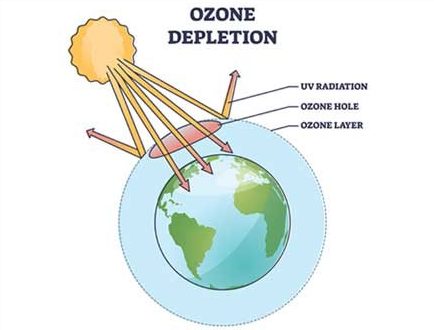Introduction – What is the Ozone Layer?
The Ozone layer is an atmospheric shield which is situated in the stratosphere, around 15 to 30 km above the Earth’s surface. Atmospheric ozone is crucial for all human beings since it absorbs ultraviolet (UV) radiation from the sun, which may be harmful when exposed to for extended periods. UV rays cause various skin diseases such as skin cancer and damage the plant and marine ecosystems, by increasing ocean acidification, affects photosynthetic activity, causing a decrease in growth of organisms, and inhibits their motility.
The biggest threat to the ozone layer is chlorofluorocarbon gases, or CFCs, used in aerosol sprays and coolants in many appliances. They are harmful since once they reach the stratosphere, they are broken down by the sun’s UV rays, and like that, become more prone to destroy Ozone. This is where the damage occurs to the ozone layer, depleting its very shielding role for the Earth, in a quicker manner than it can be naturally and sustainably replaced.
What legislation is in force and what Proposals are being made?
On the 5th of April 2022, the Commission adopted a proposal for a Regulation to be issued on fluorinated greenhouse gases and ozone depleting substances. A year later, meaning on the 5th of April, 2023, Member States of the EU finally agreed on a mandate for the Presidency to begin negotiations with the European Parliament to decrease substances that deplete the ozone layer, and moreover, cause greenhouse gas emissions.
The latter gas emissions are responsible for another negative environmental concept – that of the greenhouse effect, which is a different concept to that of ozone depletion. The greenhouse effect is one of the primary causes of climate change. How so? With the over-increase of absorption and retention of heat in the atmosphere, greenhouse gases in the air, from various human activities such as industrial combustion of fossil fuels and over-use of motor vehicle engines in the transportation sector. These two concepts should therefore not be confused.
Various EU legislation has already limited the use of both greenhouse gases and CFCS, such as through The EU Ozone Regulation, which limits the substances that deplete the ozone layer, and the ETS Directive – which establishes a system for greenhouse gas emission allowance trading within the Union and amending Council Directive 96/61/EC. However, further proposals will continue to ensure that such emissions will continue to be reduced in the atmosphere, and this will be a benefit for us all.
Unfortunately, Ozone depleting substances, or ODS, are still allowed in laboratories and chemical production, and reprocessed ODS can be used in specialised fire protection equipment like in airplanes. Additionally, fluorinated greenhouse gases, or F-gases, are found in many products used in everyday life, such as fridges, air conditioning and medicines, heat pumps and switchgear devices in electric power systems.
With new regulation in place, ozone depleting substances that are trapped into such products will be prevented from being released into the atmosphere. There will also be certain requirements to recover types of ODS, from construction waste and demolition waste, to destroy it, or even reuse it.
To ensure that the legislation remains in line with current demands, the European Council has put forward numerous recommendations for the European Parliament to consider. These include, among others, that obsolete quotas and registration requirements will turn into prohibitions instead, for better legal clarity. Secondly, the quota allocation price for CFCs (meaning the price to sell and allocate the emissions from one country to another) will be reduced from 3 to 2 euro, making it easier to allocate and distribute the emissions from countries which emit more to those countries which emit less; reaching more of an equilibrium in the allocation system of gases. Finally, bans on certain heat pumps, and air-to-water systems will be pushed further, with the aim of safeguarding other bans which would endanger the very functioning of certain mechanisms, systems and pumps.
Even though The Council and the Parliament must enter ‘trilogue’ negotiations to find an agreement on the final outlook of the regulations, for the agreement to then be formally adopted by both institutions, and promulgated, once again, Europe is definitely in the right direction in abolishing all negative repercussions that have been caused by the over use of CFC gases and greenhouse gases. Such legislative reform momentum should not halt any time soon.









